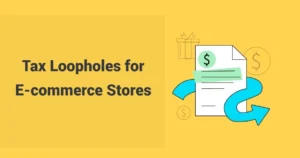Remote work has created fun new ways to work for companies in other countries without leaving your house. It is alluring and has become an integral part of the traditional office environment after the break of COVID-19. A 2023 FlexJobs survey found that 65% of remote workers report higher job satisfaction because of it.
If you’re a US citizen working remotely for a Canadian company, you might wonder: How does this affect my taxes? Don’t stress. LinkedIn data shows a 22% jump in 2024 of US citizens working remotely for foreign companies, so the need for simple tax help is huge—yet many still find taxes confusing. This guide explains it all in a clear, step-by-step way. Stay with SAL Accounting and let’s dive in!
Quick Takeaways
- You owe US federal and state taxes (e.g., California’s 1-13.3%) on Canadian earnings.
- Canada usually skips taxing you if you work from the US, per the US-Canada Tax Treaty.
- Convert CAD to USD using daily or yearly average rates for taxes.
- Employee/contractor status and Canadian benefits (like RRSPs) affect your tax bill.
Why Should You Care About Cross-Border Taxes?
With more people asking, “Can a US citizen work remotely for a Canadian company?” (spoiler: yes), these setups are popping up everywhere. Taxes might seem tricky when two countries are in the mix, but the good news? It’s not as complicated as it seems.
This post lays out your tax obligations clearly, letting you focus on your work instead of stressing over the details. We’ll cover US taxes, Canadian taxes (or the lack thereof), and practical tips. Need expert help? Check out our cross-border tax accounting between Canada and US..
Read more: “ Dropshipping taxes in Canada in 2025”
What Are Your US Tax Obligations?
As a US citizen working remotely for a Canadian company, you will have to report the income earned from the Canadian company on your US tax return. That includes what you earn from your Canadian employer while working from your US home.
Federal Income Tax
Since you’re doing the work in the US, your income counts as “US-source income.” The federal government taxes it just like any stateside job. The IRS focuses on where you are when you earn it, not where your employer sits. You can explore more about US tax rules for citizens abroad on the IRS site.
For 2023 federal tax rates for single filers, here’s how it breaks down:
| Taxable Income (USD) | Tax Rate (%) |
| $0 to $11,000 | 10 |
| $11,001 to $44,725 | 12 |
| $44,726 to $95,375 | 22 |
| $95,376 to $182,100 | 24 |
| $182,101 to $231,250 | 32 |
| $231,251 to $578,125 | 35 |
| $578,126+ | 37 |
So, if you make $75,000 a year, here’s how it works:
- You pay 10% on the first $11,000 ($1,100)
- 12% on the next $33,725 ($4,047)
- 22% on the last $30,275 ($6,660)
Add them up, and your federal tax is about $11,807.
💡 PRO TIP: File electronically with tax software to catch errors and maximize deductions; it’s faster and often cheaper than paper filing.
State Income Tax
Most states tax based on where you live. A US citizen working remotely for a Canadian company in California pays state taxes on all income, while Texas residents pay nothing since there’s no state income tax. Common state tax rates include:
- California: 1% to 13.3% (higher for big earners).
- Texas: 0% (no state income tax).
- New York: 4% to 10.9% (plus potential “convenience of employer” rules)
Check your state’s tax site for specifics.
Social Security and Medicare
You’ll pay FICA taxes for Social Security and Medicare. Social Security and Medicare taxes are also called self-employment taxes because self-employed and remote workers pay them.
- Social Security: 6.2% from you, 6.2% from your employer, up to $160,200 (2023 cap).
- Medicare: 1.45% from you, 1.45% from your employer, no cap.
The total comes to 15.3%, split evenly. Since you’re working in the US, these go to the US system, not Canada’s. The US-Canada Totalization Agreement ensures you’re not double-dipped.
💡 PRO TIP: If your employer doesn’t withhold FICA, confirm your status; misclassification can lead to unexpected tax bills. Or let our corporate tax accountants sort it out for you.
What Are Your Canadian Tax Obligations?
Good news: you probably won’t owe Canada a dime. Here’s why.
No Taxes in Canada (Usually)
Canada only taxes non-residents on income earned in Canada. If you’re working from your US couch instead of a Toronto office, your income isn’t “Canadian-sourced.” That means the Canada Revenue Agency (CRA) doesn’t get involved. Check CRA’s non-resident tax rules for details.
The US-Canada Tax Treaty Protection
Picture two countries agreeing to play nice with your paycheck. Since the US and Canada have a tax treaty, the bilateral agreement eliminates double social security and Medicare taxes.
Think of it like a referee keeping things fair. Article 15 says your income is taxed where you work, which, for you, is the US. This keeps things simple. Read the full US-Canada Tax Treaty on the IRS site.
💡 PRO TIP: Sometimes your Canadian employer might withhold taxes by mistake. If they do, ask them to stop since you’re US-based. If they don’t, claim a foreign tax credit on your US return.
Read more: “7 Canada US Tax Treaty Benefits You Need to Know“.
How Do You Handle Practical Tax Matters?
Now let’s get into the nitty-gritty of managing taxes as a US citizen working remotely for Canadian companies.
Currency Conversion
If you’re paid in Canadian dollars (CAD), you’ll need to convert it to US dollars (USD) for your tax return.
You can use the daily rate or yearly average; both are IRS-approved methods. The IRS offers exchange rate guidance for accuracy.
💡 PRO TIP: As shown in the visual, a dropping exchange rate actually lowers your US taxable income—potentially saving you tax dollars!
Employee Vs. Contractor
Your status changes how you file. Ask your employer which you are. It’s a big deal for taxes and worth getting straight.
- Employee: Income goes on Form 1040; your employer might handle FICA. You can’t deduct work expenses like a home office since 2018, though some states still let you.
- Contractor: Income goes on Schedule C; you pay self-employment tax (15.3%) but can deduct expenses like internet, equipment, or a home office to lower your tax bill. Keep receipts since proof matters.
💡 PRO TIP: Contractors should save 25-30% of income for taxes and make quarterly payments to avoid penalties. Track expenses monthly with an app like QuickBooks instead of scrambling at tax time. Our bookkeeping services in Toronto can streamline this process.
Benefits and Retirement Plans
Canadian perks like RRSP plans could get a tax break under Article 18 of the treaty. This means you pay taxes later when you take the money out.
Health insurance from your employer is usually tax-free in the US. Check with tax experts to be sure about your specific benefits package.
What Extra Reporting Rules Should You Know?
Beyond income, there are two important rules to watch if you’re dealing with Canadian finances:
- FBAR Reporting: If your Canadian bank accounts total over $10,000, you must file FinCEN Form 114 annually by April 15, with an automatic extension to October.
- FATCA Compliance: If your foreign assets exceed $50,000 (single, US-based), file Form 8938 with your tax return—big penalties apply if you skip it.
Staying on top of these requirements keeps you in the clear with the IRS.
What Happens If You Work Across Borders?
The rules shift if you cross borders.
If you’re working from Canada for a US company remotely, you’d owe Canadian taxes on that income. The US might still tax you as a citizen, but treaty credits help avoid double taxation.
For a Canadian working for a US company in Canada, it’s all Canadian taxes. The US company follows Canadian payroll rules, and there are no US tax obligations for the employee.
💡 PRO TIP: If you make short trips to Canada, log the days you worked there carefully. Spending over 183 days in Canada might trigger Canadian taxes (per treaty Article 15).
What Does This Look Like in Real Life? A Case Study
At SAL Accounting, we often get clients asking how all this tax stuff plays out in real life. So let me introduce you to Jane. She’s a real go-getter living in California, working remotely as an employee for a Canadian company. I think her story’s a great example because it shows how these rules hit home. Here’s how I broke it down for her when she brought us her CAD 100,000 salary and an exchange rate of 0.75 USD per CAD, turning it into USD 75,000.
How Jane’s Federal Taxes Break Down
When Jane came to us, I started with her federal taxes. Since she’s earning that USD 75,000 while working from her California home, it’s all US-source income. Here’s how we figured it out for her, step by step:
- $0 to $11,000: 10% = $1,100
- $11,001 to $44,725: 12% of $33,725 = $4,047
- $44,726 to $75,000: 22% of $30,274 = $6,660
Total: $11,807
In my experience, seeing these numbers laid out like this really helps clients like Jane understand where their money’s going.
Read more: “Essential Tax Implications Of Working Remotely In Canada For A US Company“.
How Jane’s State Taxes Work
Next, we looked at California’s cut. Living there means Jane’s state taxes kick in at about 6% on her USD 75,000. That comes to $4,500. I told her she’s lucky she’s not in a higher bracket yet—California can get steep fast! We always double-check these rates since they vary by state.
How Jane’s FICA Taxes Calculate
Then there’s the FICA part—Social Security and Medicare. Our team ran the numbers for Jane’s share:
- Social Security: 6.2% of $75,000 = $4,650
- Medicare: 1.45% of $75,000 = $1,087.50
Total (Jane’s share): $5,737.50
Her employer covers the other half, which is nice. I think it’s a relief for folks to know this splits evenly.
Jane’s Overall Tax Picture
Adding it all up—federal ($11,807), state ($4,500), and Jane’s FICA share ($5,737.50)—we got her grand total: $22,044.50. That’s what she’s looking at each year. When I sat down with her, she was juggling Zoom calls and coffee, so I made sure to keep it simple. In my experience at SAL Accounting, breaking it down this way gives real peace of mind to someone like Jane, who just wants to focus on her work.
Conclusion
Here’s the bottom line: If you’re a US citizen working remotely from the US for a Canadian company, you’ll owe US federal and (usually) state taxes on your income. Canada typically stays out unless you’re working from Canada for a US company remotely. Keep an eye on currency, your employment status, and any benefits—they can shift things a bit. Need help sorting it all out? Book a FREE consultation with us today. Don’t let tax confusion slow you down—let’s tackle it together!
FAQs: Your Questions Answered
No, not if you’re working from the US. Canada taxes income earned on its soil. Ask your employer to clarify if they’re unsure. It’s a quick check.
Use the exchange rate on payday or yearly average; both are IRS-approved. Check rates on the IRS site. It’s a simple step. Keep records for accuracy.
Tell them you’re US-based; if they don’t stop, claim a US tax credit. It’s an easy fix. A quick email can sort it out. Double-check their payroll setup.
Yes, if you’re a contractor; employees can’t since 2018. Keep detailed records. It lowers your tax bill nicely. Track everything monthly.
Yes, it is possible to work remotely for a Canadian company from the United States. No visa needed if you stay in the US—learn more about EIN for Canadian Companies if your employer needs US setup.
You’d owe Canadian taxes; check with a pro. The US might tax you too. Treaty rules can offset this. It’s a different ballgame.
A Canadian working for a US company in Canada pays Canadian taxes; different rules apply. The US company follows Canadian payroll. It’s a separate setup. Check CRA guidelines.
Convert to USD using fair market value on receipt date. Report it like regular income. Crypto adds a twist but isn’t hard. Document the transaction.
Maybe; if it’s short and remote work stays US-based, usually no, but check the treaty. Keep a log of days. It’s worth tracking. Small trips rarely trigger issues.
Non-cash benefits often aren’t taxable in the US; confirm with a pro. It’s usually straightforward. Ask for documentation if needed. Clarity avoids surprises.
Use estimated tax payments to avoid penalties. It smooths things out. Check IRS Form 1040-ES for guidance. It’s a smart habit.






